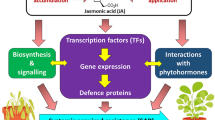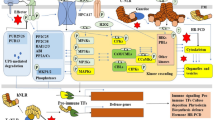Key message
Arabidopsis LONG-CHAIN BASE KINASE 1 (LCBK1) interacts with MEDEA, a component of PCR2 complex that negatively regulates immunity. LCBK1 phosphorylates phytosphingosine and thereby promotes stomatal immunity against bacterial pathogens.
Abstract
Arabidopsis polycomb-group repressor complex2 (PRC2) protein MEDEA (MEA) suppresses both pattern-triggered immunity (PTI) and effector-triggered immunity (ETI). MEA represses the expression of RPS2 and thereby attenuates AvrRpt2 effector-mediated ETI. However, the mechanism of MEA-mediated PTI diminution was not known. By screening the Arabidopsis cDNA library using yeast-2-hybrid interaction, we identified LONG-CHAIN BASE KINASE1 (LCBK1) as an MEA-interacting protein. We found that lcbk1 mutants are susceptible to virulent bacterial pathogens, such as Pseudomonas syringae pv maculicola (Psm) and P. syringae pv tomato (Pst) but not the avirulent strain of Pst that carries AvrRpt2 effector. Pathogen inoculation induces LCBK1 expression, especially in guard cells. We found that LCBK1 has a positive regulatory role in stomatal closure after pathogen inoculation. WT plants close stomata within an hour of Pst inoculation or flg22 (a 22 amino acid peptide from bacterial flagellin protein that activates PTI) treatment, but not lcbk1 mutants. LCBK1 phosphorylates phytosphingosine (PHS). Exogenous application of phosphorylated PHS (PHS-P) induces stomatal closure and rescues loss-of-PTI phenotype of lcbk1 mutant plants. MEA overexpressing (MEA-Oex) plants are defective, whereas loss-of-function mea-6 mutants are hyperactive in PTI-induced stomatal closure. Exogenous application of PHS-P rescues loss-of-PTI in MEA-Oex plants. Results altogether demonstrate that LCBK1 is an interactor of MEA that positively regulates PTI-induced stomatal closure in Arabidopsis.








Similar content being viewed by others
References
Arnaud D, Lee S, Takebayashi Y, Choi D, Choi J, Sakakibara H, Hwang I (2017) Cytokinin-mediated regulation of reactive oxygen species homeostasis modulates stomatal immunity in arabidopsis. Plant Cell 29:543–559
Banday ZZ, Nandi AK (2018) Arabidopsis thaliana GLUTATHIONE-S-TRANSFERASE THETA 2 interacts with RSI1/FLD to activate systemic acquired resistance. Mol Plant Pathol 19:464–475
Chen S, Songkumarn P, Liu J, Wang GL (2009) A versatile zero background T-vector system for gene cloning and functional genomics. Plant Physiol 150:1111–1121
Chinchilla D, Bauer Z, Regenass M, Boller T, Felix G (2006) The Arabidopsis receptor kinase FLS2 binds flg22 and determines the specificity of flagellin perception. Plant Cell 18:465–476
Choi Y, Lee Y, Jeon BW, Staiger CJ, Lee Y (2008) Phosphatidylinositol 3- and 4-phosphate modulate actin filament reorganization in guard cells of day flower. Plant, Cell Environ 31:366–377
Coursol S, Le Stunff H, Lynch DV, Gilroy S, Assmann SM, Spiegel S (2005) Arabidopsis sphingosine kinase and the effects of phytosphingosine-1-phosphate on stomatal aperture. Plant Physiol 137:724–737
Dickson RC (2010) Roles for Sphingolipids in Saccharomyces cerevisiae. Adv Exp Med Biol 688:217–231
Eun SO, Lee Y (1997) Actin filaments of guard cells are reorganized in response to light and abscisic acid. Plant Physiol 115:1491–1498
Friant S, Zanolari B, Riezman H (2000) Increased protein kinase or decreased PP2A activity bypasses sphingoid base requirement in endocytosis. EMBO J 19:2834–2844
Giri MK, Singh N, Banday ZZ, Singh V, Ram H, Singh D, Chattopadhyay S, Nandi AK (2017) GBF1 differentially regulates CAT2 and PAD4 transcription to promote pathogen defense in Arabidopsis thaliana. Plant J 91:802–815
Gomez-Gomez L, Boller T (2000) FLS2: an LRR receptor-like kinase involved in the perception of the bacterial elicitor flagellin in Arabidopsis. Mol Cell 5:1003–1011
Grossniklaus U, Vielle-Calzada JP, Hoeppner MA, Gagliano WB (1998) Maternal control of embryogenesis by MEDEA, a polycomb group gene in Arabidopsis. Science 280:446–450
Huang X, Zhang Y, Zhang X, Shi Y (2017) Long-chain base kinase1 affects freezing tolerance in Arabidopsis thaliana. Plant Sci 259:94–103
Huot B, Yao J, Montgomery BL, He SY (2014) Growth-defense tradeoffs in plants: a balancing act to optimize fitness. Mol Plant 7:1267–1287
Imai H, Nishiura H (2005) Phosphorylation of sphingoid long-chain bases in Arabidopsis: functional characterization and expression of the first sphingoid long-chain base Kinase gene in plants. Plant Cell Physiol 46:375–380
Kinoshita T, Yadegari R, Harada JJ, Goldberg RB, Fischer RL (1999) Imprinting of the MEDEA polycomb gene in the Arabidopsis endosperm. Plant Cell 11:1945–1952
Kuzmichev A, Nishioka K, Erdjument-Bromage H, Tempst P, Reinberg D (2002) Histone methyltransferase activity associated with a human multiprotein complex containing the enhancer of Zeste protein. Genes Dev 16:2893–2905
Lamaze C, Fujimoto LM, Yin HL, Schmid SL (1997) The actin cytoskeleton is required for receptor-mediated endocytosis in mammalian cells. J Biol Chem 272:20332–20335
Lee D, Bourdais G, Yu G, Robatzek S, Coaker G (2015) Phosphorylation of the plant immune regulator RPM1-INTERACTING PROTEIN4 enhances plant plasma membrane H(+)-ATPase activity and inhibits flagellin-triggered immune responses in Arabidopsis. Plant Cell 27:2042–2056
Lee MW, Yang Y (2006) Transient expression assay by agroinfiltration of leaves. Methods Mol Biol 323:225–229
Liu J, Elmore JM, Fuglsang AT, Palmgren MG, Staskawicz BJ, Coaker G (2009) RIN4 functions with plasma membrane H+-ATPases to regulate stomatal apertures during pathogen attack. PLoS Biol 7:e1000139
Luo M, Bilodeau P, Koltunow A, Dennis ES, Peacock WJ, Chaudhury AM (1999) Genes controlling fertilization-independent seed development in Arabidopsis thaliana. Proc Natl Acad Sci 96:296–301
Melotto M, Underwood W, Koczan J, Nomura K, He SY (2006) Plant stomata function in innate immunity against bacterial invasion. Cell 126:969–980
Melotto M, Zhang L, Oblessuc PR, He SY (2017) Stomatal defense a decade later. Plant Physiol 174:561
Oliva M, Butenko Y, Hsieh TF, Hakim O, Katz A, Smorodinsky NI, Michaeli D, Fischer RL, Ohad N (2016) FIE, a nuclear PRC2 protein, forms cytoplasmic complexes in Arabidopsis thaliana. J Exp Bot 67:6111–6123
Peer M, Stegmann M, Mueller MJ, Waller F (2010) Pseudomonas syringae infection triggers de novo synthesis of phytosphingosine from sphinganine in Arabidopsis thaliana. FEBS Lett 584:4053–4056
Ringrose L, Paro R (2004) Epigenetic regulation of cellular memory by the Polycomb and Trithorax group proteins. Ann Rev Genet 38:413–443
Roy A, Basak NP, Banerjee S (2012) Notch1 intracellular domain increases cytoplasmic EZH2 levels during early megakaryopoiesis. Cell Death Dis 3:e380–e380
Roy S, Nandi AK (2017) Arabidopsis thaliana methionine sulfoxide reductase B8 influences stress-induced cell death and effector-triggered immunity. Plant Mol Biol 93:109–120
Roy S, Gupta P, Rajabhoj MP, Maruthachalam R, Nandi AK (2018) The polycomb-group repressor MEDEA attenuates pathogen defense. Plant Physiol 177:1728–1742
Sah SK, Reddy KR, Li J (2016) Abscisic acid and abiotic stress tolerance in crop plants. Front Plant Sci 7:571–571
Singh N, Swain S, Singh A, Nandi AK (2018) AtOZF1 Positively regulates defense against bacterial pathogens and NPR1-independent salicylic acid signaling. Mol Plant Microb Interact 31:323–333
Singh V, Roy S, Singh D, Nandi AK (2014) Arabidopsis flowering locus D influences systemic-acquired-resistance- induced expression and histone modifications of WRKY genes. J Biosci 39:119–126
Su IH, Dobenecker M-W, Dickinson E, Oser M, Basavaraj A, Marqueron R, Viale A, Reinberg D, Wülfing C, Tarakhovsky A (2005) Polycomb group protein Ezh2 controls actin polymerization and cell signaling. Cell 121:425–436
Su J, Zhang M, Zhang L, Sun T, Liu Y, Lukowitz W, Xu J, Zhang S (2017) Regulation of stomatal immunity by interdependent functions of a pathogen-responsive MPK3/MPK6 cascade and abscisic acid. Plant Cell 29:526–542
Ton J, Flors V, Mauch-Mani B (2009) The multifaceted role of ABA in disease resistance. Trends Plant Sci 14:310–317
Varet A, Hause B, Hause G, Scheel D, Lee J (2003) The Arabidopsis NHL3 gene encodes a plasma membrane protein and its overexpression correlates with increased resistance to Pseudomonas syringae pv. tomato DC3000. Plant Physiol 132:2023–2033
Waadt R, Schmidt LK, Lohse M, Hashimoto K, Bock R, Kudla J (2008) Multicolor bimolecular fluorescence complementation reveals simultaneous formation of alternative CBL/CIPK complexes in planta. Plant J 56:505–516
Zanolari B, Friant S, Funato K, Sutterlin C, Stevenson BJ, Riezman H (2000) Sphingoid base synthesis requirement for endocytosis in Saccharomyces cerevisiae. EMBO J 19:2824–2833
Zhang D, Tian C, Yin K, Wang W, Qiu JL (2019) Postinvasive bacterial resistance conferred by open stomata in rice. Mol Plant Microb Interact 32:255–266
Zhang J, Zhou JM (2010) Plant immunity triggered by microbial molecular signatures. Mol Plant 3:783–793
Zheng X, Kang S, Jing Y, Ren Z, Li L, Zhou JM, Berkowitz G, Shi J, Fu A, Lan W, Zhao F, Luan S (2018) Danger-associated peptides close stomata by OST1-independent activation of anion channels in guard cells. Plant Cell 30:1132–1146
Acknowledgements
We acknowledge ABRC, Ohio State University for mutant seeds. This work was supported by the Science and Engineering Research Board project (SERB/SR/SO/PS/150/2012 to AKN), and the CSIR fellowship to SR and PG.
Author information
Authors and Affiliations
Contributions
PG-performed most of the experiments, analyzed data, and designed some of the experiments; SR-performed some of the experiments; AN-conceptualized the designed most of the experiments. PG and AN-wrote the manuscript, which has been further modified and approved by all authors.
Corresponding author
Additional information
Publisher's Note
Springer Nature remains neutral with regard to jurisdictional claims in published maps and institutional affiliations.
Electronic supplementary material
Below is the link to the electronic supplementary material.
Rights and permissions
About this article
Cite this article
Gupta, P., Roy, S. & Nandi, A.K. MEDEA-interacting protein LONG-CHAIN BASE KINASE 1 promotes pattern-triggered immunity in Arabidopsis thaliana. Plant Mol Biol 103, 173–184 (2020). https://doi.org/10.1007/s11103-020-00982-4
Received:
Accepted:
Published:
Issue Date:
DOI: https://doi.org/10.1007/s11103-020-00982-4




